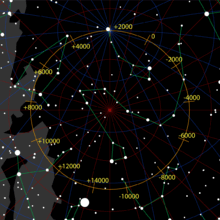Tau Herculis
| Observation data Epoch J2000 Equinox J2000 | |
|---|---|
| Constellation | Hercules |
| Right ascension | 16h 19m 44.4368s[1] |
| Declination | 46° 18′ 48.119″[1] |
| Apparent magnitude (V) | 3.89[1] |
| Characteristics | |
| Spectral type | B5 IV[1] |
| U−B color index | -0.57[2] |
| B−V color index | -0.155[2] |
| Astrometry | |
| Radial velocity (Rv) | -13.8[1] km/s |
| Proper motion (μ) | RA: -13.15[1] mas/yr Dec.: 39.31[1] mas/yr |
| Parallax (π) | 10.37 ± 0.53 mas[3] |
| Distance | 310 ± 20 ly (96 ± 5 pc) |
| Absolute magnitude (MV) | −0.96[4] |
| Details | |
| Mass | 4.9[5] M☉ |
| Radius | 3.55±0.19[6] R☉ |
| Luminosity | 574[4] L☉ |
| Surface gravity (log g) | 4.02±0.05[6] cgs |
| Temperature | 15,615±301[6] K |
| Metallicity [Fe/H] | 0.15[7] dex |
| Rotational velocity (v sin i) | 46[8] km/s |
| Age | 1[5] Gyr |
| Other designations | |
| Database references | |
| SIMBAD | data |
Tau Herculis, Latinized from τ Herculis, is a fourth-magnitude star in the constellation Hercules. It is a blue subgiant star, seven hundred times more luminous than the Sun.
Properties
Tau Herculis has a stellar classification B5IV. Its mass is 4.9 times solar.[5] Though its apparent magnitude is only 3.89, like all B-class stars, it is very luminous, boasting a total bolometric luminosity that is 700 times solar.[5] Hipparcos estimated its distance at roughly 96 parsecs from Earth, or 310 ± 20 light years away.
Pole Star

Tau Herculis is a visible star located within 1° of the precessional path traced across the celestial sphere by the Earth's North pole. It was the northern pole star around the year 7400 BC, a phenomenon which is expected to reoccur in the year 18,400 due to precession.[5]
The current pole star is, of course, Polaris. Among the 14 stars that could be reasonably[weasel words] considered eventual northern pole stars, Tau Herculis is the dimmest, but only Polaris itself and Thuban are closer to the precessional path.[citation needed]
| Preceded by | Pole Star | Succeeded by |
|---|---|---|
| Iota Herculis | 18,400 AD | Edasich |
Etymology
Its traditional name, Rukbalgethi Shemali, is of Arabic origin and shares certain etymological characteristics with the stars Ruchbah and Zubeneschamali, signifying Hercules' "northern knee".[9]
In Chinese, 七公 (Qī Gōng), meaning Seven Excellencies, refers to an asterism consisting of τ Herculis, 42 Herculis, φ Herculis, χ Herculis, ν1 Boötis, μ1 Boötis and δ Boötis.[10] Consequently, the Chinese name for τ Herculis itself is 七公二 (Qī Gōng èr, Template:Lang-en.)[11]
References
- ^ a b c d e f g "* tau Her". SIMBAD. Centre de données astronomiques de Strasbourg. Retrieved 2010-06-10.
- ^ a b Mermilliod, J.-C. (1986), "Compilation of Eggen's UBV data, transformed to UBV (unpublished)", Catalogue of Eggen's UBV Data, Bibcode:1986EgUBV........0M
{{citation}}: Unknown parameter|agency=ignored (help) - ^ Perryman, M. A. C.; et al. (1997), "The Hipparcos Catalogue", Astronomy & Astrophysics, 323: L49 – L52, Bibcode:1997A&A...323L..49P
- ^ a b Anderson, E.; Francis, Ch. (2012), "XHIP: An extended hipparcos compilation", Astronomy Letters, 38 (5): 331, arXiv:1108.4971, Bibcode:2012AstL...38..331A, doi:10.1134/S1063773712050015.
- ^ a b c d e Kaler, James B., "TAU HER (Tau Herculis)", Stars, University of Illinois, retrieved 2018-04-27
- ^ a b c Fitzpatrick, E. L.; Massa, D. (March 2005), "Determining the Physical Properties of the B Stars. II. Calibration of Synthetic Photometry", The Astronomical Journal, 129 (3): 1642–1662, arXiv:astro-ph/0412542, Bibcode:2005AJ....129.1642F, doi:10.1086/427855
- ^ Smith, K. C.; Dworetsky, M. M. (1993), "Elemental Abundances in Normal Late B-Stars and Hgmn-Stars from Co-Added IUE Spectra - Part One - Iron Peak Elements", Astronomy and Astrophysics, 274 (2): 335, Bibcode:1993A&A...274..335S
- ^ Royer, F.; et al. (2002), "Rotational velocities of A-type stars in the northern hemisphere. II. Measurement of v sin i in the northern hemisphere", Astronomy and Astrophysics, 393 (3): 897–911, arXiv:astro-ph/0205255, Bibcode:2002A&A...393..897R, doi:10.1051/0004-6361:20020943
- ^ Kurt Vonnegut. "Constellations: Hercules 'the Strongman'". The BBC (British Broadcasting Corporation). Retrieved 2010-11-14.
- ^ (in Chinese) 中國星座神話, written by 陳久金. Published by 台灣書房出版有限公司, 2005, ISBN 978-986-7332-25-7.
- ^ (in Chinese) AEEA (Activities of Exhibition and Education in Astronomy) 天文教育資訊網 2006 年 6 月 26 日

